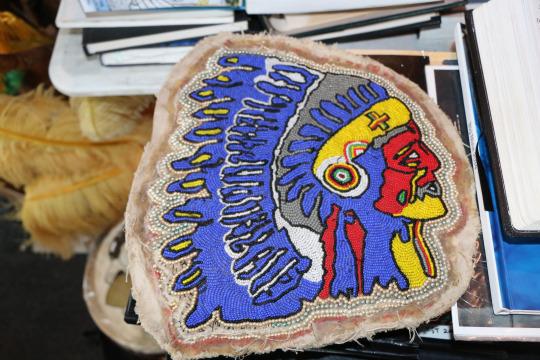Tucked away in the Lower Ninth Ward, just blocks from where the levee broke, is a unique museum, even for New Orleans. Located in a building in the back of 1317 Tupelo Street is the House of Dance & Feathers — a rough-and-tumble museum dedicated to the Mardi Gras Indian tribes. Founded by Ronald Lewis, the head of the Choctaws, the museum is full of feathered headdresses, intricately beaded chest plates, glittery costumes and, in the corner, a case of water worn shoes, that, despite the wear, still hold their fabulousness.
Related: The Stolen Generation: Australia’s Dark and Tragic Past
“Those were my shoes that were all ruined by Katrina,” Lewis said. “Ostrich, alligator — thousands of dollars of my good shoes just ruined. I used to wear them during the parades, but now I place them there to remind people of what was lost. They’re still too nice to throw away.”

Lewis hand-beaded this chest plate and saved it from Katrina.
Ten years ago when Katrina hit, Lewis’ home and museum were covered in flood waters.
“I lost pretty much everything that I didn’t take with me,” he said. “I grabbed these beaded works and a few other things, and my wife and I fled. When I came back it was all gone.”
Lewis and his wife spent almost a year with family in Thibideaux, La., before coming back to New Orleans and rebuilding from the ground up — with help from “the great people of America.” Lewis, like many families in the Ninth Ward, didn’t receive direct compensation from the government or the Red Cross. “Fortunately, I was on NPR and so donations came in,” he said. “Don’t get me started on the government ‘funds’ or the Red Cross.” He shakes his head. “I don’t like to dwell on bad feelings.”
Related: This Burmese Nunnery Saved 300 Girls From Sex Slavery
Just last month, Lewis finally put the finishing touches on his house and museum.

Ronald outside his museum. (Photo: House of Dance & Feathers)
“I’m trying to keep this culture alive. It started in slavery, when the slaves were allowed out on Sundays — the only day they could congregate — to Congo square and they would beat the drums with the Indians. We learned form the Indians and started our own tribes — which march in Mardi Gras and in weekly parades from September to May.”
